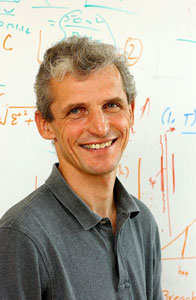  |
| HOME | THIS ISSUE | CALENDAR | GRANTS | BACK ISSUES | < BACK | NEXT > |
Nobel Prize-winner to give Katzenstein physics lecture - September 5, 2006 |
||||
| The physics department's 2006 Katzenstein Distinguished Lecture on Sept. 15 will again feature a Nobel Prize-winning physicist: Wolfgang Ketterle, who shared the 2001 Nobel Prize in physics for creating Bose-Einstein condensation (BEC). The phenomenon had been predicted by Albert Einstein in 1925, based on work the year before in India by Satyendra Nath Bose.
Ketterle, the John D. MacArthur Professor of Physics at the Massachusetts Institute of Technology, and two scientists at the University of Colorado independently created BECs 70 years after Einstein's prediction, and were the first to do so. Ketterle also was the first to demonstrate the atom laser in 1997. Ketterle's lecture on Sept. 15 at 4 p.m. in Room P-36 of the Gant Science Complex will be on "New Forms of Matter Close to Absolute Zero Temperature." The Bose-Einstein condensate has been called the "fifth state of matter." In creating and characterizing it, Ketterle and others provided the biggest breakthrough of many in recent years in the area of ultracold physics, says William Stwalley, Board of Trustees Distinguished Professor of Physics and department head. A report now being drafted by the National Research Council shows how breakthroughs in quantum mechanics such as BEC "have developed into a very powerful theme, which is changing physics and science more generally," Stwalley says. Ketterle's laboratory at MIT has been described as a place where visitors "had better bring a sweater. " While the ultracold group in physics at UConn may cool atoms down to one hundred millionths of a degree Kelvin, Ketterle's lab may dip down to approximately one billionth of a degree, which is called a nanoKelvin, says Stwalley. In his Nobel Lecture in 2001, Ketterle noted that "Laypeople may wonder why 'freezing cold' is not cold enough." NanoKelvin temperatures are necessary to explore quantum-degenerate gases such as Bose-Einstein condensates, he explained. At ultracold temperatures, the wave properties of quantum particles such as atoms and molecules become more important, says Stwalley. Studying the wave-like behavior of particles is the basis of quantum mechanics. Among the new areas of study and the applications opened up by this wave-like behavior are superfluids and other novel kinds of matter, quantum computing, and quantum cryptography, he adds. "There's been a real change in the scope of atomic and molecular physics from what it was 20 years ago," Stwalley says. Ketterle, 48, grew up in Heidelberg, Germany. His interest in the technical world began by playing with Legos and in taking apart old radios and TVs. He was disappointed with electronic kits because they only showed how to put parts together, not how they worked, he wrote in his autobiography. He studied to the equivalent of a master's degree at the Technical University of Munich, received a Ph.D. in physics from the University of Munich in 1986, and did postdoctoral work at the Max-Planck Institute for Quantum Optics in Germany and the University of Heidelberg, before coming to MIT as a postdoctoral fellow in 1990. He became an assistant professor at MIT in 1993 and has been the MacArthur Professor since 1998. The Katzenstein lecture and prize in physics at UConn was endowed 10 years ago by the late Henry S. Katzenstein, who earned the first Ph.D. in physics at UConn in 1954. Among the previous Katzenstein lecturers was one of the Nobelists who shared the physics prize in 2001 with Ketterle, Eric Cornell of the University of Colorado. |
| ADVANCE HOME |

